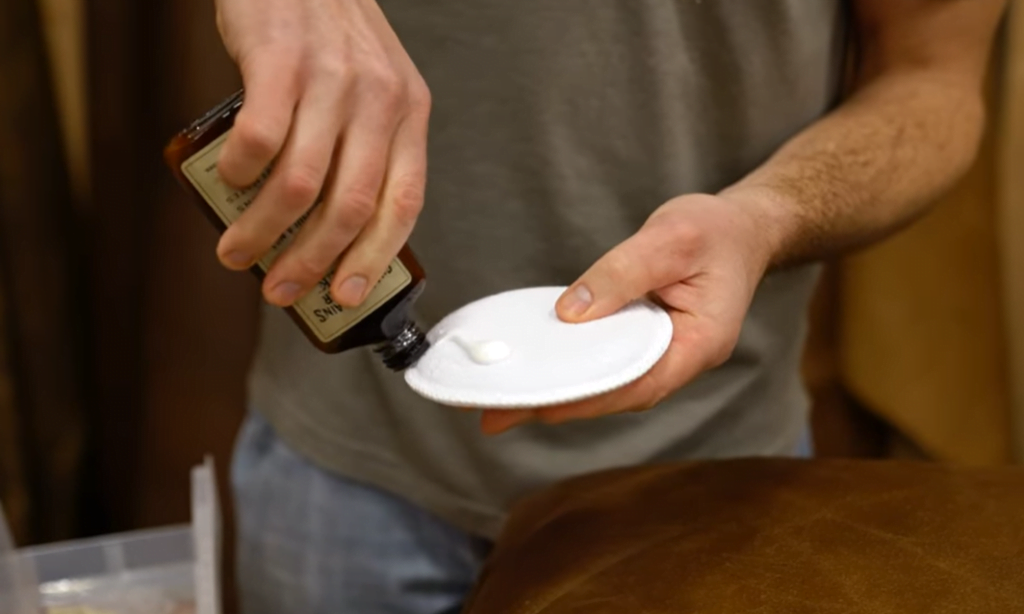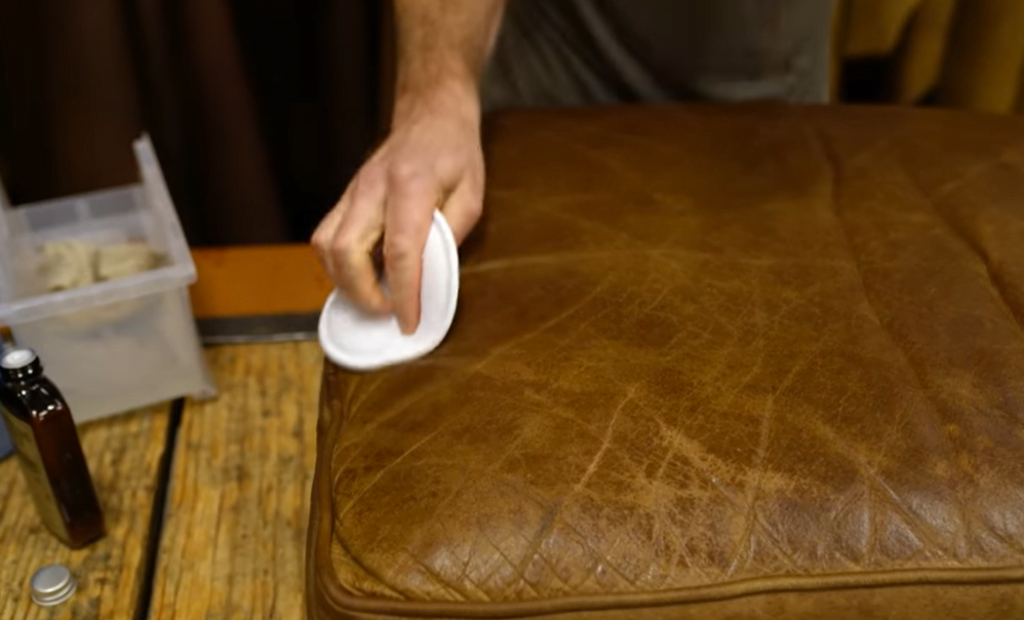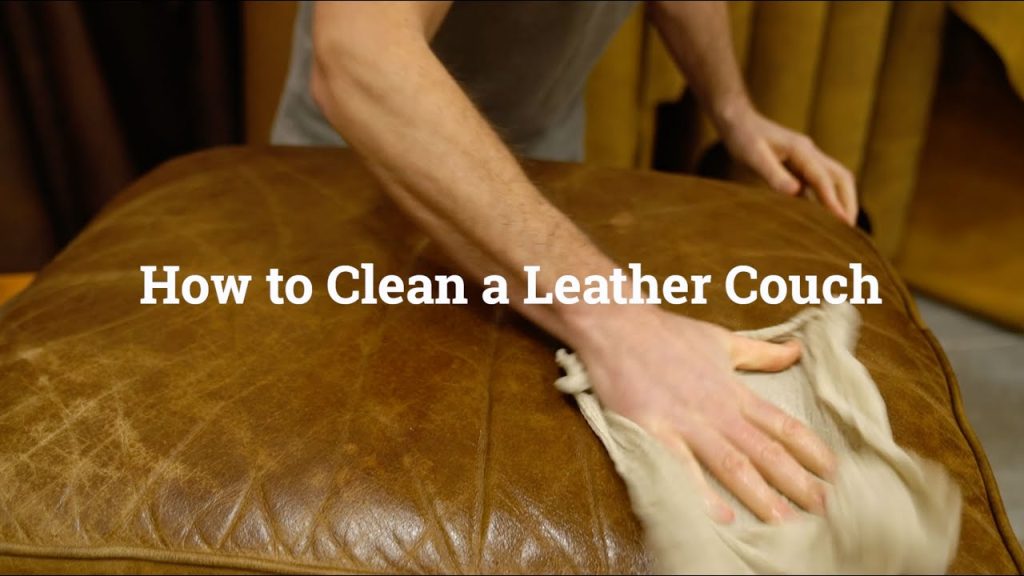How Do You Clean a Leather Chair, regularly wipe it down with a soft cloth and use a leather-specific cleaner for deeper cleaning. Avoid harsh chemicals that can damage the leather.
Maintaining the pristine condition of a leather chair is essential for its longevity and aesthetic appeal. Leather, a durable yet sensitive material, calls for attentive care to prevent premature wear and tear. Caretakers of leather furnishings should be well informed on the appropriate methods to keep their chairs looking luxurious.
Regular cleaning not only preserves the leather’s quality but also ensures it remains a comfortable and stylish addition to any space. A routine that involves dusting and gentle washing can keep your leather chair in top shape, making it a timeless piece of your home or office decor. Knowing the right techniques to care for leather can make all the difference in safeguarding this valuable investment.

Introduction To Leather Chair Maintenance
Leather chairs add elegance to any room. Like skin, leather needs regular care to look its best. Neglect can lead to cracking, peeling, or stains. Proper maintenance ensures durability and beauty for years. This guide covers essential tips for keeping leather chairs in tip-top shape.
Understanding The Importance Of Regular Cleaning
Regular cleaning prevents dirt accumulation. Dirt can cause surface scratches and fade the color of your leather chair. Clean leather chairs not only look better, but they also prevent premature wear. By cleaning consistently, you save money on future repairs or replacements. Start a cleaning routine to keep leather supple and vibrant.
Different Types Of Leather And Their Cleaning Needs
Not all leather is alike. Recognize your chair’s leather type for the right cleaning approach. Here are some common types:
- Aniline: This is soft, dyed leather without a clear topcoat. It’s receptive to specialized cleaners. Avoid water; it can stain aniline.
- Semi-aniline: Like aniline but with a thin protective topcoat. It’s more durable and can handle a gentle damp cloth.
- Pigmented: These have a heavy finish and are the easiest to maintain. Use simple leather cleaner solutions.
Use appropriate products for each leather type, ensuring longevity and appealing aesthetics. Mistakes can lead to damage or discoloration. Always execute a spot test in an unseen area first.

Before You Start: Pre-cleaning Considerations
Leather chairs add elegance to any room. But before diving into cleaning them, some prep work is crucial. It helps to maintain the integrity of the leather. Let’s focus on the key steps to consider before starting.
Checking Manufacturer’s Instructions And Warnings
Always check the manufacturer’s guide first. Leather chairs come with specific care instructions. These can include important warnings about what products or methods to avoid. Following these instructions helps prevent damage or unintentionally voiding warranty coverages.
- Find the care tag or manual.
- Read the dos and don’ts.
- Respect warranty requirements.
Identifying And Testing Leather Cleaning Products
Choosing the right products is essential. Test any cleaner you plan to use. Do this in a small, hidden area of the chair. This step avoids potential discoloration or damage to the leather’s surface.
| Test Procedure | Observation |
|---|---|
| Apply the cleaner on a small spot. | Check for discoloration. |
| Wait for the spot to dry. | Ensure no damage occurs. |
Keep these pre-cleaning steps in mind to ensure a safe and effective cleaning process. Preserve the beauty of your leather by being thorough in your preliminary checks.
Daily And Weekly Care Routines
Maintaining your leather chair is a must for longevity. Daily and weekly care routines keep the leather supple. They prevent cracks and stains. These simple steps will ensure your leather chair stays looking great.
Dusting Techniques For Leather Chairs
Regular dusting prevents buildup. It’s a key part of your daily routine. Use a soft cloth or a feather duster.
- Dust gently in a circular motion.
- Avoid using colored clothes that might bleed.
- Focus on crevasses where dust may hide.
Regular Wiping Practices To Prevent Build-up
A weekly wipe down is essential. It removes the dirt that daily dusting misses.
What you’ll need:
- Microfiber cloth
- Mild soap solution (dilute a small drop of soap in water)
- Distilled water (to avoid water spots)
Clean using a damp cloth. No dripping water or soap suds. Follow up with a dry cloth immediately.
Deep Cleaning Your Leather Chair
Welcome to the essential guide on deep cleaning your leather chair. Leather furniture brings a touch of elegance to any room, but maintaining its luxurious look requires proper care. In this section, we’ll discover how to deep clean your leather chair to restore its natural beauty and extend its life.
Choosing The Right Cleaning Solution For Leather
Not all cleaners are safe for leather. It’s crucial to select the right cleaning solution. Ideal cleaners should be:
- pH-balanced to match the natural pH of leather
- Alcohol-free to prevent drying out the material
- Gentle and non-abrasive to avoid damaging the surface
You can opt for commercial leather cleaners or make a homemade mix with equal parts water and white vinegar.
Step-by-step Guide To Cleaning Leather Surfaces
To deep clean your leather chair, follow these steps:
- Remove large debris: Use a soft brush or vacuum with a brush attachment to remove crumbs and dirt.
- Prepare the cleaning solution: Mix or choose your cleaner as mentioned above.
- Test in an inconspicuous area: Apply a small amount of cleaner to ensure it doesn’t damage or discolor the leather.
- Apply the cleaner: Use a soft cloth, lightly dampened with the cleaner. Work in sections, gently wiping the surface.
- Wipe off excess: Quickly but gently remove any excess cleaner with a dry cloth.
- Condition the leather: After cleaning, apply a leather conditioner to replenish oils and keep the leather soft.
For stains, make a paste with one part lemon juice and one part cream of tartar. Apply to the stain and let sit for 10 minutes, then wipe off.
Conditioning After Cleaning
Once your leather chair sparkles from a good clean, remember to give it some TLC. Conditioning after cleaning is like a spa treatment for leather. It keeps the material soft, supple, and happy.
Benefits Of Leather Conditioning
Why condition leather? After all, it’s just a chair, right? Wrong! Think of your leather chair as skin. Like skin, leather needs moisture to stay healthy. Look at the wonders conditioning can do:
- Prevents Cracking: Dry leather can crack. Moisturize to keep it intact.
- Repels Water: Conditioned leather handles spill better.
- Longevity: A well-cared-for chair lasts years longer.
- Enhances Appearance: Conditioner brings out the leather’s natural sheen.
Applying Leather Conditioner Properly
Getting your leather chair to look its best requires the right touch with conditioner. Use these steps for a flawless finish:
- Choose Wisely: Pick a conditioner made for leather.
- Test First: Try it on a small area. Make sure it’s good.
- Gentle Application: Use a soft cloth. Rub conditioner in circles.
- Event Coverage: Don’t miss spots. Keep the layer uniform.
- Let It Soak: Give the conditioner time to absorb. Wait before using the chair.
By conditioning your leather chair after cleaning, you’re not just maintaining its looks. You’re investing in its future. Treat it right, and your chair will be a companion for years to come!
Spot Cleaning And Stain Removal
Spot cleaning and stain removal on leather chairs keep them looking sharp and fresh. However not all stains are the same, and treating them correctly is key to maintaining the integrity of the leather. This section dives into the nitty-gritty of banishing blemishes without damaging your beloved chair.
Identifying Different Types Of Stains
Different stains require unique approaches. It’s vital to recognize the stain type before starting the cleaning process. Doing so will increase the chance of total removal without harming the leather.
| Stain Type | Characteristics |
|---|---|
| Grease | Slippery and darkens leather |
| Ink | Saturated color, often blue or black |
| Liquid | Spreads quickly and may leave a ring |
| Food | Can be oily or dry, leaves residue |
Effective Techniques For Spot Cleaning
- Begin by blotting excess liquid from the stain with a clean, dry cloth. Avoid rubbing as it can spread the stain.
- For grease stains, sprinkle baking soda or cornstarch on the area, let it sit for a few hours, then brush away.
- For ink stains, use a cotton swab dipped in rubbing alcohol to gently dab at the stain until it lifts.
- Tackle liquid stains by lightly dampening the leather with distilled water and non-detergent soap, then clean gently.
- Food residues often require leather cleaner specially formulated for the purpose.
Dealing With Difficult Stains And Spills
Clean leather chairs need special care. Stains and spills can be tricky. But, worry not! The right approach can lift them away. Gentle methods keep leather looking great.
Ink, Grease, And Oil Stain Treatments
Ink stains demand quick action. Gently dab with a cotton swab dipped in isopropyl alcohol. Do not rub as it can spread the ink.
For grease and oil, sprinkle talcum powder or cornstarch. Let it sit to absorb the oil. Brush it gently off after a few hours.
| Stain Type | Treatment | What to Avoid |
|---|---|---|
| Ink | Dab with isopropyl alcohol | Rubbing the stain |
| Grease/Oil | Apply talcum powder or cornstarch | Wiping with water |
Red Wine And Other Tannin Stains
Blot red wine spills fast with a clean cloth. Next, mix mild soap with water. Use a cloth to apply. Rinse with a damp cloth. Dry with a towel.
- Blot: Use a clean cloth immediately.
- Clean: Mild soap and water solution.
- Rinse: A slightly damp cloth.
- Dry: Soft towel to prevent damage.
Preventive Measures To Keep Leather Chairs Clean
Keeping a leather chair in top-notch condition requires careful maintenance. Effective preventive measures protect the chair’s material before dirt and damage take their toll. Explore the best practices to safeguard your leather investment.
Using Throws And Covers
Throws and covers act as leather’s first defense line. They shield the leather from spills, stains, and wear. For an easy clean-up, choose washable covers. These covers prolong your chair’s life and keep it looking new.
- Opt for lightweight fabrics that won’t suffocate the leather.
- Ensure covers are snug to prevent slippage.
- Choose breathable materials to maintain leather’s natural qualities.
Avoiding Sunlight And Heat Damage
Sunlight and heat can fade and damage leather. Position chairs away from windows or shield them with curtains. Maintain a stable room temperature to prevent leather from drying and cracking.
| Tips | Benefits |
|---|---|
| Use UV-blocking window treatments. | Minimizes discoloration. |
| Keep a safe distance from heat sources. | Prevents leather warping. |
| Regularly condition the leather. | Keeps it supple and resistant to damage. |
Repairing And Touching Up Leather Chairs
Over time, leather chairs show their age with scratches, scuffs, and sometimes even cracks. Yet, with the right approach, those beloved pieces can look as good as new. The secret lies in knowing how to repair and touch up your leather chair effectively. Whether you choose a DIY route or professional services, each has its advantages. Let’s dive into how to keep your leather furniture looking its best.
Fixing Scratches And Cracks
Minor scratches can often be blended away with gentle buffing. Use a soft cloth and special leather cream. For deeper scratches and cracks, a leather repair kit comes in handy. Here’s a simple guide:
- Clean the area with a leather-friendly cleaner.
- Apply the repair compound from the kit.
- Smooth it out and let it dry according to the instructions.
- Once dry, apply leather dye that matches your chair.
Always test any product in an inconspicuous spot first.
Diy Leather Repair Vs. Professional Services
| DIY Leather Repair | Professional Services |
|---|---|
| Cheaper cost | Higher cost |
| Suitable for small fixes | Best for severe damage |
| Requires your time | Time-saving option |
| Various kits available | Expert craftsmanship |
While DIY kits can save money and are useful for minor repairs, they can’t match the level of detail and longevity a professional can provide for more extensive damage. When deciding, consider the severity of the damage and the value of the chair.

Addressing Common Concerns And Mistakes
Cleaning a leather chair takes more than a quick wipe. It’s a delicate business. Many chair owners make mistakes that cost beauty and durability. Let’s talk about these common issues and how to avoid them.
Using Household Cleaning Agents On Leather
Leather is sensitive to harsh chemicals. Regular cleaners may seem convenient but can harm your chair. Don’t grab windows or all-purpose cleaners for this task. They can dry out leather, leading to cracks.
- Stick to products designed for leather.
- Make a natural solution with vinegar and olive oil if you prefer DIY.
Mitigating Wear And Tear Over Time
Every chair faces wear and tear. But you can slow it down. Keep your leather chair away from direct sunlight and heat sources. This can prevent fading and drying out.
- Condition your chair every six months.
- Use a soft cloth for cleaning and drying, not abrasive materials.
Regular maintenance can extend your chair’s life significantly.
Eco-friendly And Natural Cleaning Solutions
Cleaning leather furniture can be gentle on the environment too! By choosing natural products, it’s easy to maintain the pristine condition of a leather chair without harsh chemicals. Not only do these eco-friendly options protect the Earth, but they also guard the quality and longevity of your furniture. Explore some tried-and-true homemade cleaning mixtures and learn about the benefits of essential oils in leather care. A spotless, nourished leather chair awaits, all thanks to the power of nature.
Homemade Leather Cleaning Mixtures
Simple, natural ingredients can work wonders on leather surfaces. Here’s a list of effective homemade leather cleaning solutions:
- Vinegar and Olive Oil: Mix equal parts to gently clean and condition.
- Castile Soap Mix: A few drops in warm water can lift dirt without damaging leather.
- Lemon Juice and Cream of Tartar: Combine to create a paste for spot treatment.
Apply gently with a soft cloth, then wipe off with a damp cloth. For best results, follow up with a dry cloth.
The Role Of Essential Oils In Leather Care
Essential oils aren’t just for aroma; they can enhance leather care too. Look at these benefits:
- They sanitize naturally, killing germs without damage.
- Condition and soften leather with their moisturizing properties.
- Essential oils like lemon or eucalyptus leave a fresh, clean scent.
Add a few drops to your cleaning mixtures for a gentle, effective, and aromatic clean.
Conclusion: Preserving The Life Of Your Leather Chair
Preserving the life of your leather chair requires attention to detail and a commitment to regular care. Wrapping up our guide on keeping your leather chair in pristine condition, we solidify the essentials of maintenance that can safeguard your investment for years to come.
Summary Of Best Practices For Leather Care
- Clean spills quickly to prevent staining.
- Use a soft cloth for dusting.
- Vacuum crevices to remove dirt.
- Avoid harsh chemicals that can damage leather.
- Apply a quality leather conditioner periodically.
- Keep your chair away from direct sunlight and heat sources.
Reflecting On The Value Of Maintenance And Regular Upkeep
Maintaining your leather chair is crucial. Regular upkeep not only keeps the chair looking its best but also extends its life. Think of it as a routine that both enhances and protects your furniture’s beauty and comfort. Through simple, consistent care, your leather chair remains not just a piece of furniture, but a valued part of your home or office décor for years of enjoyment.
Frequently Asked Questions On How Do You Clean A Leather Chair
What Is The Best Cleaner For Leather Chairs?
The best cleaner for leather chairs is a pH-balanced leather cleaner specifically designed for leather furniture. It cleans without damaging the leather while maintaining its natural oils.
Can You Use Vinegar To Clean Leather Chairs?
No, vinegar is not recommended for cleaning leather chairs as its acidity can damage the leather. Instead, use a leather-specific cleaner or a mild, water-based solution sparingly.
How Often Should I Condition A Leather Chair?
Leather chairs should be conditioned every 6 to 12 months. Regular conditioning helps maintain the leather’s suppleness and prevents cracking.
Are There Natural Methods To Clean Leather?
Yes, natural cleaning methods like using a damp cloth with mild soap can be effective for gentle cleaning. Test a small, inconspicuous area first to ensure no discoloration.
Conclusion
Maintaining your leather chair’s luster is simpler than you might think. Regular wiping and spot-cleaning, complemented with periodic conditioning, keeps it in top-notch condition. Embrace these straightforward steps to ensure your leather furniture remains a timeless asset in your space.
Here’s to the lasting beauty and comfort of your cherished leather chair!

